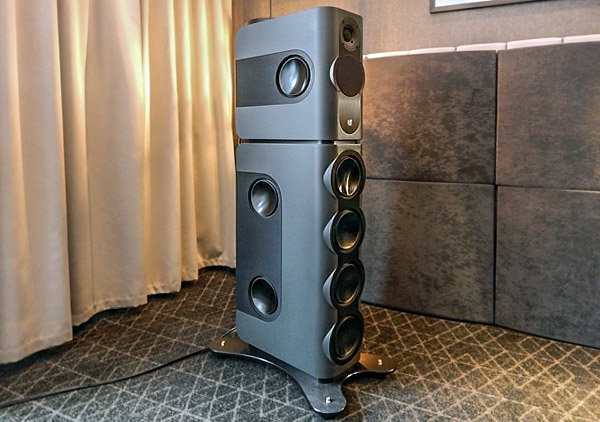| Columns Retired Columns & Blogs |
Hopefully, with lots of trickle down!

All prices are in Canadian dollars.
The first time I heard a pair of standmount Kii Audio Three speakers, a few years back at a Montreal Audiofest, I immediately got them—their sound, their purpose, their futuristic, polished look. I was infatuated by these strange, complex, almost entirely self-sufficient sound-reproduction devices, so unlike anything else I'd seen they may as well have been from outer space ($21,278).
What makes the Kii Three so different from everything else? Start with the fact that it’s a fully active, digital speaker, with 1500W of amplification, DSP, and low-frequency extension specified to 20Hz, ±0.5dB, in a relatively small package. By default, there’s one XLR input per speaker, intended for connection to an analog preamplifier.
One of the neatest features of the Kii Three is its cardioid design, which means that most of the energy, even in the bass and low mids, is projected forward, toward the listening position, which makes placement easier and renders the room less important.
Turns out, the Threes are part of something bigger, which I encountered in the room run by Montreal-based Studio Economik, a store known for catering to the pro-audio industry. That "something bigger" is the BXT system ($42,023), which includes two Kii Three standmounts, two BXT modules, a Kii Control unit, and all necessary cables. The Kii Control unit provides DSP control and acts as a digital preamplifier. With the Kii Control in the system, connectivity to the speakers is via RJ45 cables, though it isn’t network-enabled. The Control adds S/PDIF (on RCA and TosLink) and USB inputs up to 24/384 PCM and DSD128
The most important difference between the Threes and the BXT System is the addition of the BXT modules. To the Kii Three's six drivers per side—one tweeter, one midrange, four woofers—each BXT module, which also acts as a speaker stand for a Kii Three, adds 8 woofers, bringing the total number of woofers per speaker to 10 and the total number of drivers to 14, each with its own 250W class-D amplification.
This is not a system for tweakers or those who like to play with a lot of different components, because the Kii Three BXT system handles everything except the music data; there’s not much left to play with. Just add a streamer (such as the Wattson Audio Emerson Digital ($2095) used here, and you’re good to go.
On files streamed via Apple Music, the sound I heard was effortless, robust, expansive, well-sorted, dense, colorful, pure-sounding and detailed. It made many other speakers sound slow and congested in comparison. Cabling by Mogami.

Hopefully, with lots of trickle down!

There is a smaller Kii Seven.

The BXT System sounds like it could stun small animals at 50 feet!